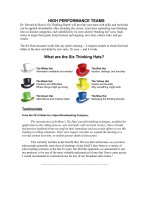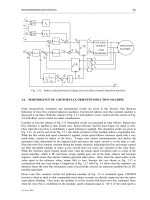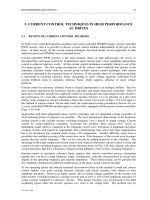Creating high performance teams
Bạn đang xem bản rút gọn của tài liệu. Xem và tải ngay bản đầy đủ của tài liệu tại đây (3.09 MB, 417 trang )
CREATING HIGH PERFORMANCE TEAMS
APPLIED STRATEGIES AND TOOLS FOR
MANAGERS AND TEAM MEMBERS
Creating High Performance Teams is an accessible and thorough new
introduction to this key area of business education. Written by teams experts
Ramon J. Aldag and Loren W. Kuzuhara, this book provides students with
both a firm grounding in the key concepts of the field and the practical tools
to become successful team managers and members. Built on a solid foundation of the most up-to-date research and theory, the chapters are packed
with case studies, real-world examples, and tasks and discussion questions,
while a companion website supports the book with a wealth of useful resources for students, team members, and instructors.
Centered around an original model for high performance teams, topics
covered include the following:
•
•
•
•
•
•
Building and developing effective teams
Managing diversity
Fostering effective communication
Team processes—meetings, performance management
Dealing with change and team problems
Addressing current issues—virtual teams, globalization
With its combined emphasis on principles and application, interwoven
with the tools, topics, and teams issues most relevant today, Creating High
Performance Teams is perfectly placed to equip upper-level undergraduate
and MBA students with the knowledge and skills necessary to take on teams
in any situation.
Ramon (Ray) J. Aldag is a professor in the Department of Management
and Human Resources at the Wisconsin School of Business, University of
Wisconsin–Madison, USA. He holds the Glen A. Skillrud Family Chair in
Business.
Loren W. Kuzuhara is a teaching professor in the Department of Management
and Human Resources at the Wisconsin School of Business, University of
Wisconsin–Madison, USA.
This page intentionally left blank
CREATING
HIGH PERFORMANCE
TEAMS
Applied Strategies and
Tools for Managers and Team Members
RAMON J. ALDAG AND LOREN W. KUZUHARA
First published 2015
by Routledge
711 Third Avenue, New York, NY 10017
and by Routledge
2 Park Square, Milton Park, Abingdon, Oxon, OX14 4RN
Routledge is an imprint of the Taylor & Francis Group, an informa business
© 2015 Taylor & Francis
The right of Ramon J. Aldag and Loren W. Kuzuhara to be identified as
authors of this work has been asserted by them in accordance with
sections 77 and 78 of the Copyright, Designs and Patents Act 1988.
All rights reserved. No part of this book may be reprinted or reproduced or
utilised in any form or by any electronic, mechanical, or other means, now
known or hereafter invented, including photocopying and recording, or in
any information storage or retrieval system, without permission in writing
from the publishers.
Trademark notice: Product or corporate names may be trademarks or
registered trademarks, and are used only for identification and explanation
without intent to infringe.
Library of Congress Cataloging-in-Publication Data
Aldag, Ramon J., 1945–
Creating high performance teams : applied strategies and tools for
managers and team members / Ramon J. Aldag and Loren W. Kuzuhara.
pages cm
Includes bibliographical references and index.
1. Teams in the workplace. 2. Organizational behavior. I. Kuzuhara,
Loren W. II. Title.
HD66.A43 2015
658.4′022—dc23
2014025765
ISBN: 978-0-415-53491-8 (hbk)
ISBN: 978-0-415-53841-1 (pbk)
ISBN: 978-0-203-10938-0 (ebk)
Typeset in Sabon & Frutiger
by Apex CoVantage, LLC
For my wife, Deborah Douglas; our children, Kat Aldag,
Lizzie Aldag Carley, Drew Douglas, and Wyn Douglas; our daughter-in-law,
Shahree Douglas; our son-in-law, Eli Carley Olson; our grandson,
Anthony Fazzari; and our bichon frise, Lily.
RAMON J. ALDAG
For my wife, Lavina, my son, Daniel, and my daughter, Carolyn.
LOREN W. KUZUHARA
This page intentionally left blank
BRIEF CONTENTS
List of Figures
A Visual Tour of Creating High Performance Teams
xvii
xxiii
CHAPTER 1
Teams: Opportunities and Challenges
1
CHAPTER 2
Designing the Team System
26
CHAPTER 3
Building and Developing the Team
48
CHAPTER 4
Socializing, Building Trust, Training, Motivating,
and Leading Teams
67
CHAPTER 5
Managing Team Diversity
111
CHAPTER 6
Fostering Effective Communication in Teams
143
CHAPTER 7
Facilitating Team Processes
162
CHAPTER 8
Managing Change in Teams
193
CHAPTER 9
Dealing with Team Problems
210
CHAPTER 10
Teams: Evaluating Team Effectiveness
245
CHAPTER 11
The New Teams:
Virtual, Global, Connected, and Self-Managing
269
Designing and Implementing Team-Based
Organizations
302
Teams Summary and Integration
324
CHAPTER 12
CHAPTER 13
Glossary
Subject Index
Author Index
339
369
380
This page intentionally left blank
CONTENTS
List of Figures
A Visual Tour of Creating High Performance Teams
CHAPTER 1
CHAPTER 2
xvii
xxiii
Teams: Opportunities and Challenges
1
Learning Objectives
Team Management and Why It Matters
Maximizing the Value of This Text for
Your Career Success
Differences between Groups and Teams
Types of Teams in Organizations
Characteristics of Effective Teams
The Scholtes Team Model
The Hill and Anteby Model for Analyzing Teams
Practical Implications of the Hill and Anteby Model
John Maxwell’s “17 Indisputable Laws of Teamwork”
American Society for Quality’s International
Team Excellence Criteria
Common Problems with Teams
Five Dysfunctions of a Team
An Integrated Model for High Performance Teams
Summary and Integration
1
1
19
22
22
23
24
Designing the Team System
26
Learning Objectives
Designing a Team System
Developing Team Scope and Objectives: The Team Charter
Basic Elements of a Team Charter
Procedure for Developing a Team Charter
Practical Guidelines for Using a Team Charter
Developing a Team Project Timeline: Gantt Chart
Benefits of a Gantt Chart
Procedure for Developing a Gantt Chart
Practical Guidelines for Using a Gantt Chart
Developing a Role Responsibilities Matrix
What Is It?
Benefits of a Role Responsibilities Matrix
Procedure for Developing a Role
Responsibilities Matrix
26
26
27
27
30
30
32
34
34
36
37
37
39
5
6
7
11
12
13
16
17
39
CONTENTS
CHAPTER 3
CHAPTER 4
Practical Guidelines for Using a Role
Responsibilities Matrix
Developing a Team Dashboard
What Is a Team Dashboard?
Benefits
Procedure for Developing a Team Dashboard
Practical Guidelines for Using a Team Dashboard
Summary and Integration
39
41
41
42
43
44
44
Building and Developing the Team
48
Learning Objectives
Choosing a Team Size and Members
Selecting a Team Size
Staffing the Team
Strategies for Forming Effective Teams
Defining the Team’s Assignment
Planning the Team Effort
Developing the Team
Norms
Roles
Stages of Team Development
Building Team Spirit
Summary and Integration
48
48
48
50
50
52
52
53
53
55
58
60
62
Socializing, Building Trust, Training,
Motivating, and Leading Teams
67
Learning Objectives
Socializing Team Members
Team Socialization
Roles in Team Socialization
Identity Fusion
Team Cognition: Mental Models and Transactive
Memory Systems
Developing Trust within the Team
What Is Trust?
The Importance of Trust in Teams
Bases of Trust
Applying the Bases of Trust
“Swift Trust”
Managing Trust
The Fragility of Trust
Training Team Members
Importance of Team Training
Forms of Team Training
Motivating and Rewarding Team Members
Basics of Motivation
X
67
67
67
67
68
68
69
69
69
70
72
73
73
73
73
73
74
75
76
CONTENTS
CHAPTER 5
CHAPTER 6
Learning Theory
Need Theories of Motivation
Setting Effective Goals
Team-Based Rewards
Expectancy Theory
Equity Theory
Intrinsic Motivation
Group Potency and Collective Efficacy
Leading Teams
Leadership Defined
Emerging Perspectives
Leadership and Power
Leader Traits
Key Leader Behaviors and Skills
When Is Leadership Needed?
Transformational Leadership
Leader Affect and Group Mood
Summary and Integration
76
79
81
83
85
86
88
89
90
90
90
91
91
92
94
96
98
100
Managing Team Diversity
111
Learning Objectives
Managing Diversity
Forms of Diversity
Fostering Diverse Teams
Training for Tolerance
Rewarding Diversity Efforts
Developing Favorable Attitudes toward Diversity
Confronting the Challenges of Diverse Teams
Group Fault Lines
Managing Conflict
Providing a Bridge across Diversity
Protecting the Views of the Minority
Understanding Personality
Emotional Intelligence
Important Personality Dimensions
Recognizing Cross-Cultural Differences
Cultural Intelligence
Summary and Integration
111
112
113
113
114
114
114
115
115
116
116
118
120
121
124
129
129
133
Fostering Effective Communication in Teams
143
Learning Objectives
Functions of Communication
Understanding Communication Barriers
Semantics
Distraction
Misrepresentation
143
145
145
145
146
146
XI
CONTENTS
CHAPTER 7
CHAPTER 8
XII
Information Retention
Perceptual Factors
Overcoming Communication Barriers
Guidelines for Effective Speaking
Mastering Active Listening
Coaching and Counseling
Forms of Nonverbal Communication
Summary and Integration
146
149
149
150
152
153
153
155
Facilitating Team Processes
162
Learning Objectives
Designing and Conducting Team Meetings
Helping Team Members Become Acquainted
Providing a Facilitative Setting
Considering Spatial Arrangements
Giving Structure to Meetings: Before, During,
and After
Before the Meeting
During the Meeting
After the Meeting
Making Team Decisions
The Problem-Solving Process
PDCA: A Team Problem-Solving Process
Biases
Guidelines to Avoid Overreliance on
Concurrence Seeking
Using Special-Purpose Team Techniques
Summary and Integration
162
162
162
163
163
Managing Change in Teams
193
Learning Objectives
The Change Process
Balancing Forces for and against Change
Sources of Resistance to Change
Self-Interest
Uncertainty
Lack of Understanding and Trust
Differing Perceptions
Lack of Tolerance for Change
Approaches to Overcoming Resistance to Change
Logos
Ethos
Pathos
Other Approaches to Change
Team-Based Change: Team Insurrections
Managing Difficult Transitions
193
193
194
195
195
196
196
196
196
198
198
200
200
200
201
202
167
167
168
171
172
173
176
177
178
180
186
CONTENTS
1. Clearly Explain the Reasons for the Transition:
Show How Endings Ensure Continuity
2. Explain Why the Transition Is Occurring in
the Way It Is Occurring
3. Minimize Uncertainty: Define What Is Over
and What Is Not
4. Identify Who Is Losing What
5. Acknowledge Losses Openly and Sympathetically
6. Expect and Accept Signs of Grieving
7. Provide Fair Compensation for Losses
8. Facilitate the Coping of Those with Losses
9. Mark the Endings
10. Treat the Past with Respect
11. Plan for New Beginnings
Summary and Integration
CHAPTER 9
CHAPTER 10
202
203
203
203
203
204
204
204
204
204
204
205
Dealing with Team Problems
210
Learning Objectives
Diagnosing Team Problems
Types of Problem Team Behaviors
Practical Guidelines for Dealing with Problem Behaviors
Groupthink
Managing Conflict
A Conflict Model
Conflict Types
Potential Benefits of Conflict
Conflict Styles
Contingency Factors for Handling Conflict
Conflict-Intervention Approaches
Negotiating Good Outcomes
Managing Interteam Relations and Conflict
Strategies for Enhancing Interteam Cooperation
and Reducing Conflict
Turning around Failing Teams
Reviving Zombie Teams
Team Crisis Management
Team Culture Change
Summary and Integration
210
211
212
213
215
218
219
220
221
223
225
227
228
228
Teams: Evaluating Team Effectiveness
245
Learning Objectives
Overview of Evaluating Team Effectiveness
General Objectives of Traditional Performance
Evaluations
Challenges When Conducting Traditional
Performance Evaluations
245
245
229
231
231
231
234
237
247
247
XIII
CONTENTS
Overview of Team-Based Performance Evaluation Systems
Potential Benefits
Potential Drawbacks
Team Performance Evaluation Systems
General Characteristics of Effective Team Performance
Evaluation Systems
Common Mistakes When Using 360-Degree Feedback
Guidelines for Effective Team Feedback Sessions
Team Audit Support from the Organization and Top
Management
Methods for Linking Team Evaluation to
Performance Improvement
Tree Diagrams
Accountability Documents
Summary and Integration
CHAPTER 11
The New Teams: Virtual, Global,
Connected, and Self-Managing
Learning Objectives
The Changing Environment for Teams
Globalization
Increased Turnover
Growing Computer Literacy and the Explosion
of Information Technology
New Office Forms
Reduced Focus on Hierarchy
Robotics
Rate of Change
Virtual Teams
Benefits of Virtual Teams
Challenges of Virtual Teams
Leading Virtual Teams
Using e-Communications
Global Teams
Team Collaborative Technology
Self-Managing Teams
The Need for Self-Management
Consequences of Self-Management
Forms of Self-Management
Guidelines for Behavioral Self-Management
Cognitive-Focused Strategies for Self-Management
Self-Leadership in Teams
Behavioral Aspects of Team Self-Leadership
Cognitive Aspects of Team Self-Leadership
The Convergence
Summary and Integration
XIV
247
247
248
248
249
251
259
262
263
263
264
266
269
269
269
269
269
270
270
271
272
272
273
274
274
275
278
278
280
286
287
287
287
288
289
290
290
291
291
291
CONTENTS
CHAPTER 12
Designing and Implementing
Team-Based Organizations
Learning Objectives
Characteristics of Team-Based Organizations
Importance of Team-Based Organizations
Factors Driving the Movement toward Team-Based
Organizations
Benefits of Team-Based Organizations
Challenges Associated with Implementing Team-Based
Organizations
Readiness to Become a Team-Based Organization
Models of Team-Based Organizations
The Mohrman, Cohen, and Mohrman Team-Based
Organization Model
The Forrester and Drexler Team-Based
Organization Model
Best Practices for the Successful Implementation
of Team-Based Organizations
The Trent Model for Becoming an Effective Teaming
Organization
The Plan Phase
The Perform Phase
The Evaluate Phase
The Maintain Phase
Summary and Integration
CHAPTER 13
302
302
305
305
306
306
307
309
309
310
311
315
316
317
318
318
319
320
Teams Summary and Integration
324
Learning Objectives
Coming Full Circle: Revisiting the High Performance
Teams Model
Phase 1: Designing the Team System
Phase 2: Developing the Team
Phase 3: Facilitating the Team
Phase 4: Evaluating the Team
The Team Context: Organizational and External
Environments
Moving Forward: Opportunities to Develop Teamwork
and Team Management Skills as a Student
Take Academic Coursework and Participate in
Workshops on Teams
Join Student Organizations to Obtain Teamwork
and Team Management Experience
Join Student Competition Teams
Read Books, Newsletters, and Other Publications
Engage in Volunteer/Service Learning Team
Experiences
324
324
324
325
326
327
328
328
328
329
330
330
330
XV
CONTENTS
Join LinkedIn and Build Your Teamwork Network
Obtain Internships That Provide Opportunities for
Teamwork or Team Management
Opportunities to Develop Teamwork and Team
Management Skills as a Working Professional
Key Practical Takeaways for You as a Team Member
Key Practical Takeaways for You as a Team Leader
Journey’s End
Glossary
Subject Index
Author Index
XVI
331
331
331
332
334
335
339
369
380
FIGURES
Chapter 1: Teams: Opportunities and Challenges
Qualities That Employers Seek on
a Job Candidate’s Resume
3
FIGURE 1-2
Characteristics of Groups and Teams
6
FIGURE 1-3
Comparison of Types of Work Teams
8
FIGURE 1-4
The Hill and Anteby Model
14
FIGURE 1-5
Maxwell’s “17 Indisputable Laws of Teamwork”
17
FIGURE 1-6
The Five Dysfunctions of a Team
22
FIGURE 1-7
The High Performance Teams Model
24
FIGURE 1-1
Chapter 2: Designing the Team System
FIGURE 2-1
Sample Team Charter
28
FIGURE 2-2
Sample Gantt Chart
33
FIGURE 2-3
Sample Gantt Chart Set-Up
35
FIGURE 2-4
Sample Role Responsibilities Matrix
for a Fund Raising Project
38
FIGURE 2-5
Role Responsibilities Matrix Template
40
FIGURE 2-6
Sample Team Dashboard
42
FIGURE 2-7
Team Dashboard Gauge for Cholesterol
44
Chapter 3: Building and Developing the Team
FIGURE 3-1
Effects of Team Size
50
FIGURE 3-2
Team Roles
56
FIGURE 3-3
Stages of Group Development
59
Chapter 4: Socializing, Building Trust, Training,
Motivating, and Leading Teams
FIGURE 4-1
Measurement of Trust in Teams
69
FIGURE 4-2
Moderators and Consequences of the Impact
of Team Training
74
FIGURES
FIGURE 4-3
Operant Conditioning
77
FIGURE 4-4
The Need-Satisfaction Process
79
FIGURE 4-5
Maslow’s Hierarchy of Needs
80
FIGURE 4-6
Key Goal Characteristics
81
FIGURE 4-7
Factors Influencing Effectiveness
of Team-Based Rewards
84
FIGURE 4-8
The Job Characteristics Model
88
FIGURE 4-9
Group Potency, Collective Efficacy,
and Group Performance
90
FIGURE 4-10
Autocratic and Democratic Styles
93
FIGURE 4-11
Consideration and Initiating Structure
94
FIGURE 4-12
Some Substitutes for and Neutralizers
of Leadership
95
A Model of Group Emotional Contagion
99
FIGURE 4-13
Chapter 5: Managing Team Diversity
FIGURE 5-1
Dimensions of Emotional Intelligence
123
FIGURE 5-2
The Big Five Personality Dimensions
128
FIGURE 5-3
Some Roles of National Culture in Teams
132
Chapter 6: Fostering Effective Communication in Teams
FIGURE 6-1
Forms of Nonverbal Communications
154
Chapter 7: Facilitating Team Processes
Zones of Personal Space for Those Raised
in the United States
164
FIGURE 7-2
Seating Arrangements for Different Activities
166
FIGURE 7-3
Summary of Team Facilitation Diagnostic
Questions and Potential Interventions
170
FIGURE 7-4
The Problem-Solving Process
173
FIGURE 7-5
The PDCA Model
176
FIGURE 7-6
Steps in the Nominal Group Technique
184
FIGURE 7-1
Chapter 8: Managing Change in Teams
XVIII
FIGURE 8-1
The Lewin Change Model
194
FIGURE 8-2
Force Field Analysis
195
FIGURES
FIGURE 8-3
Sources of Resistance to Change
195
FIGURE 8-4
Individual Differences in Attitudes
toward Change
197
FIGURE 8-5
Change Approaches
198
FIGURE 8-6
The Rhetorical Triangle
198
FIGURE 8-7
Deciding When to Use the Change Approaches
201
Chapter 9: Dealing with Team Problems
FIGURE 9-1
Groupthink Model
217
FIGURE 9-2
A Conflict Model
219
FIGURE 9-3
Team Conflict Types and Examples
221
FIGURE 9-4
Conflict Styles
224
FIGURE 9-5
Fitting Conflict Style to the Situation
226
FIGURE 9-6
Conflict-Intervention Approaches
227
FIGURE 9-7a
Team Liaison Role
230
FIGURE 9-7b
Cross-Team Group
230
FIGURE 9-7c
Team Integrator Role
230
FIGURE 9-7d
Dual Team Memberships
230
Chapter 10: Teams: Evaluating Team Effectiveness
FIGURE 10-1
Cycle of Dysfunctional Teams
246
FIGURE 10-2
Common Problems with Traditional
Performance Evaluation Methods
247
FIGURE 10-3
Sources of Feedback for Team Evaluations
249
FIGURE 10-4
Key Areas and Critical Factors from
the TEaM Model
250
FIGURE 10-5
Kline and McGrath Team Performance Criteria
250
FIGURE 10-6
Common Mistakes Associated with
360-Degree Feedback Process Systems
252
Typical Sources of Feedback for Elements
of Team Systems
252
360-Degree Process for Evaluating Team
Performance
253
Sample Self-Evaluation Questions for Team
Evaluations
254
FIGURE 10-7
FIGURE 10-8
FIGURE 10-9
FIGURE 10-10 Summary of Suggested Team Feedback
Systems for Different Types of Teams
255
XIX
FIGURES
FIGURE 10-11 Sample Questions for Direct Report Evaluations,
Peer Evaluations, and Customer Evaluations
of Teams
257
FIGURE 10-12 Sample Excerpt from a 360-Degree
Feedback Report
258
FIGURE 10-13 Sample Action Plan Worksheet Based
on 360-Degree Feedback Process
260
FIGURE 10-14 Sample Tree Diagram Improving Customer
Service and Satisfaction at a Retail Store
FIGURE 10-15 Sample Accountability Document
263
265
Chapter 11: The New Teams: Virtual, Global, Connected,
and Self-Managing
FIGURE 11-1
Virtual Teams
273
FIGURE 11-2
Managing the Life Cycle of Virtual Teams
276
FIGURE 11-3
Practices of Effective Virtual-Team Leaders
277
FIGURE 11-4
Choosing When and How to Use
e-Communication Methods
278
LeafHopper: A thinkLet Example for
Divergent Thinking
283
Examples of thinkLets
284
FIGURE 11-5
FIGURE 11-6
Chapter 12: Designing and Implementing Team-Based
Organizations
FIGURE 12-1
A Team-Based Organization
303
FIGURE 12-2
A Traditional Functional Organizational Design
304
FIGURE 12-3
Readiness Review Assessment Questions
for Team-Based Organizations
309
Indicators of Readiness for Team-Based
Organizations
310
Mohrman, Cohen, and Mohrman Effectiveness
Framework for Team-Based Knowledge
Organizations
311
Mohrman, Cohen, and Mohrman Design
Sequence for Transition to a Team-Based
Organization
312
Key Tasks or Activities at Each Step in
the Design Sequence Model
312
FIGURE 12-4
FIGURE 12-5
FIGURE 12-6
FIGURE 12-7
XX
FIGURES
FIGURE 12-8
FIGURE 12-9
The Forrester and Drexler Team-Based
Organization Model
313
Keys and Off/Keys in the Team-Based
Organizational Performance Model
314
FIGURE 12-10 Key Elements for Success of Team-Based
Organizations
315
FIGURE 12-11 Best Practices for Team-Based Organizations
316
FIGURE 12-12 The Plan Phase of the Trent Model
317
FIGURE 12-13 The Perform Phase of the Trent Model
318
FIGURE 12-14 The Evaluate Phase of the Trent Model
318
FIGURE 12-15 The Maintain Phase of the Trent Model
319
Chapter 13: Teams Summary and Integration
FIGURE 13-1
The High Performance Teams Model
325
XXI
This page intentionally left blank
A VISUAL TOUR OF
CREATING HIGH
PERFORMANCE TEAMS
Pedagogical Features
Creating High Performance Teams possesses a number of features that
are designed to engage students, enhance understanding of key concepts,
and facilitate the development of skills for effective team leadership and
membership.
The High Performance Teams Model
The High Performance Teams Model provides a basic integrated conceptual
framework that organizes the overall chapter topics covered in the text. It
shows the sequence of phases in which a team is formed, developed, and
enhanced through an ongoing process of evaluation and continuous refinement of the team system. This framework is useful in that it emphasizes that
teams must be structured and managed as a system and that a systematic
process is needed in order for team leaders and members to be effective.
Team Context: The Organization and The External Environment
Team Leader
Designing the
Team System
Developing
the Team
Facilitating
the Team
Evaluating
the Team
Team Members
Learning Objectives
Each chapter begins with a set of Learning Objectives, which note the things
the student should be able to do after reading the chapter. These objectives
provide both an introduction to the chapter’s content and a checklist to
ensure that the student has subsequently focused on all key issues.
Teams in the News
This feature provides examples of news stories from major publications and
websites that illustrate a wide variety of team issues from fields such as business, sports, and health care. These stories help students see the relevance of
team concepts, strategies, and tools as they affect the functioning and effectiveness of teams in the workplace. Many of these news stories also illustrate
useful strategies that team leaders use to develop their teams.
A VISUAL TOUR OF CREATING HIGH PERFORMANCE TEAMS
TEAMS IN THE NEWS: The Chilean Mine Disaster1
The Chilean Mine Disaster offers a dramatic example of the power of team leadership and teamwork under conditions of tremendous time pressure, threat,
and stress. On the afternoon of August 5, 2010, more than 700,000 metric tons
of rock collapsed, blocking the central passage to the tunnels in the San José
copper-gold mine in Chile’s Altacama Desert. A second earthquake followed two
days later. 33 men were trapped deep underground, their location and condition
Team Scholar
Team Scholar profiles present interviews with academicians who are experts
on team management and discuss what these experts have learned through
their research in the field. These profiles help students not only understand
the empirical research that is the foundation for much of the existing knowledge on team functioning and effectiveness but also learn about scholars’
views on the status and future directions of team research.
TEAM SCHOLAR
Astrid C. Homan, University of Amsterdam
Astrid C. Homan (Ph.D., 2006, University of Amsterdam) is an assistant professor of work and organizational psychology at the University of Amsterdam. Her
research interests include team diversity, team processes, team performance,
subgroup salience, leadership, and diversity beliefs. She is particularly interested in determining how to harvest the potential value in diversity. Her work is
published in outlets such as the Journal of Applied Psychology, Journal of Personality and Social Psychology, Organizational Behavior and Human Decision
Processes, and Academy of Management Journal.
1. What sparked your interest in diversity in work groups?
My first interest related to group processes, as I wondered why some groups
are productive and efficient, whereas other groups are not. I quickly found that
the composition of the group (on any dimension) was a strong predictor of the
processes that occurred within the group. As our societies and organizations
get more and more
Team Management Coach
This feature presents interviews with individuals who have experience with
leading and/or working on various types of teams and describes what they
have learned about team management as a result. Many interviewees offer
specific guidance to students regarding the actions they can take to become
more effective team leaders and members.
XXIV









